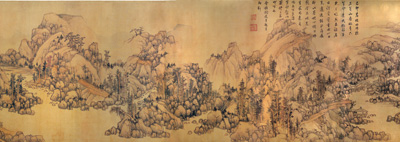|
||
      |
Next Generation
The long and winding scroll
A University project has put the scroll back in handscroll. The Center for the Art of East Asia is digitizing handscroll paintings so that students and researchers can view them as the artists intended. A major Chinese art form, the paintings—typically two to 30 feet long—are meant to be unrolled horizontally and examined section by section, “to create a moving picture,” center director Wu Hung explains. In slides or textbook reproductions, “this feeling, the temporality, is lost.”

Lan Ying, Landscape (after Huang Gongwang), c. 1637–1638, Smart Museum
Until winter quarter, that’s all Wu had to work with. Dating back to the fifth or sixth century, many handscrolls are too fragile to be removed from storage, let alone held. The digitization provides access—and mimics the scrolling experience. So far 19 paintings have been scanned or photographed in parts and electronically stitched together. From a database, viewers can see them on a computer screen as a continuous image. They can stop, go back and forth, or zoom in and out.
In his class on handscrolls Wu, the Harrie H. Vanderstappen distinguished
service professor of art history, has tested the tool with students. It
“really gave them all these ideas,” he says. “Their papers
became much richer and in discussion [they had] much more to say.”
With teaching and research applications in mind, he and Katherine Mino,
PhD’96, the center’s associate director, plan to expand the
project, adding reproductions and original paintings.